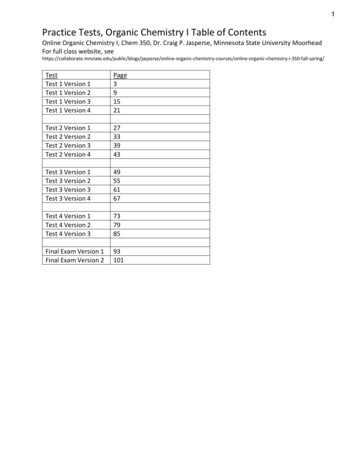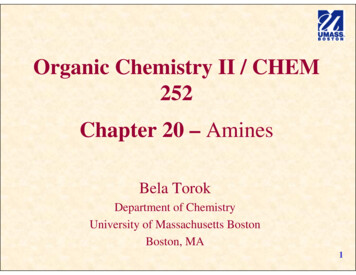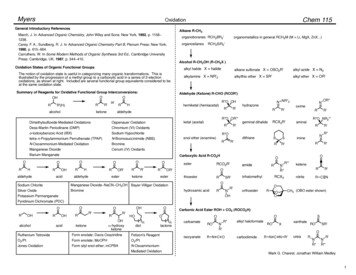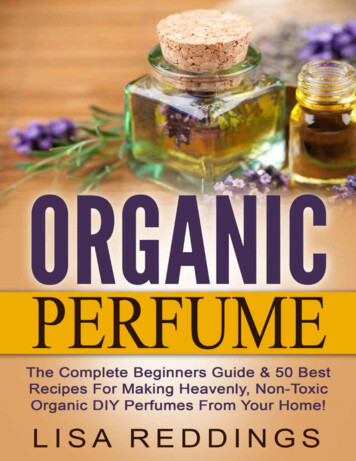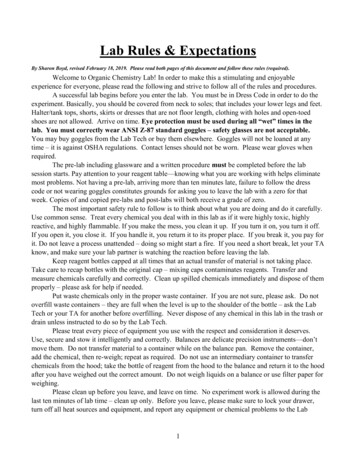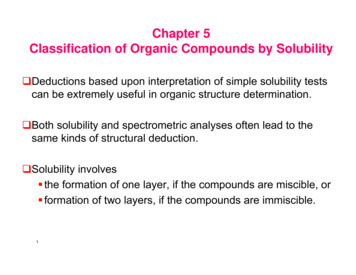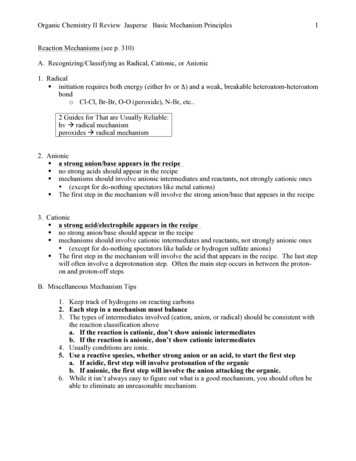
Transcription
Organic Chemistry II Review Jasperse Basic Mechanism Principles1Reaction Mechanisms (see p. 310)A. Recognizing/Classifying as Radical, Cationic, or Anionic1. Radical§ initiation requires both energy (either hv or Δ) and a weak, breakable heteroatom-heteroatombondo Cl-Cl, Br-Br, O-O (peroxide), N-Br, etc.2 Guides for That are Usually Reliable:hv à radical mechanismperoxides à radical mechanism2. Anionic§ a strong anion/base appears in the recipe§ no strong acids should appear in the recipe§ mechanisms should involve anionic intermediates and reactants, not strongly cationic ones (except for do-nothing spectators like metal cations)§ The first step in the mechanism will involve the strong anion/base that appears in the recipe3. Cationic§ a strong acid/electrophile appears in the recipe§ no strong anion/base should appear in the recipe§ mechanisms should involve cationic intermediates and reactants, not strongly anionic ones (except for do-nothing spectators like halide or hydrogen sulfate anions)§ The first step in the mechanism will involve the acid that appears in the recipe. The last stepwill often involve a deprotonation step. Often the main step occurs in between the protonon and proton-off stepsB. Miscellaneous Mechanism Tips1. Keep track of hydrogens on reacting carbons2. Each step in a mechanism must balance3. The types of intermediates involved (cation, anion, or radical) should be consistent withthe reaction classification abovea. If the reaction is cationic, don’t show anionic intermediatesb. If the reaction is anionic, don’t show cationic intermediates4. Usually conditions are ionic.5. Use a reactive species, whether strong anion or an acid, to start the first stepa. If acidic, first step will involve protonation of the organicb. If anionic, the first step will involve the anion attacking the organic.6. While it isn’t always easy to figure out what is a good mechanism, you should often beable to eliminate an unreasonable mechanism.
Organic Chemistry II Review Jasperse Basic Mechanism Principles2Some Arrow-Pushing Guidelines (Section 1.14)1. Arrows follow electron movement.2. Some rules for the appearance of arrows The arrow must begin from the electron source. There are two sources:a. An atom (which must have a lone pair to give)b. A bond pair (an old bond that breaks) An arrow must always point directly to an atom, because when electrons move, theyalways go to some new atom.3. Ignore any Spectator Atoms. Any metal atom is always a “spectator” When you have a metal spectator atom, realize that the non-metal next to it must havenegative charge4. Draw all H’s on any Atom Whose Bonding Changes5. Draw all lone-pairs on any Atom whose bonding changes6. KEY ON BOND CHANGES. Any two-electron bond that changes (either made orbroken) must have an arrow to illustrate: where it came from (new bond made) or an arrow showing where it goes to (old bond broken)7. Watch for Formal Charges and Changes in Formal Charge If an atom’s charge gets more positive Þ it’s donating/losing an electron pair Þ arrowmust emanate from that atom or one of it’s associated bonds. There are two “morepositive” transactions: When an anion becomes neutral. In this case, an arrow will emanate from theatom. The atom has donated a lone pair which becomes a bond pair. When a neutral atom becomes cationic. In this case, the atom will be losing abond pair, so the arrow should emanate from the bond rather than from the atom. If an atom’s charge gets more negative Þ it’s accepting an electron pair Þ an arrow mustpoint to that atom. Ordinarily the arrow will have started from a bond and will point tothe atom.8. When bonds change, but Formal Charge Doesn’t Change, A “Substitution” is Involved Often an atom gives up an old bond and replaces it with a new bond. This is“substitution”. In this case, there will be an incoming arrow pointing directly at the atom (to illustrateformation of the new bond), and an outgoing arrow emanating from the old bond thatbreaks
Organic Chemistry II Review Jasperse Some Fundamental Stability/Reactivity Principles14.16 Reactive Intermediates: Stability Patterns Shortlived, unstable, highly reactive intermediatesNormally lack normal bondingThese are tremendously important:1. They will be the least stable intermediate in any multistep mechanism2. When formed, they are products of the rate-determining step3. Factors that stabilize them will speed up reaction ratesThus it is very important to know their stability patterns!ClassStructureCarbocationsStability PatternAllylic 3º 2º 1º methyl alkenyl(vinyl, aryl)Electron Electrophilic/PoorAcidicCarbonRadicalsCAllylic 3º 2º 1º methyl alkenyl(vinyl, aryl)Electron Electrophilic/PoorAcidicCAllylic alkenyl (vinyl, aryl) methyl 1º 2º 3ºElectron Nucleophilic/RichBasicCCarbanionsNotes1. Both carbocations and radicals have the same pattern. So you don’t need to memorize themtwice!2. Carbanions are almost exactly the reverse, except that being allylic is ideal for both.3. All benefit from resonance (allylic).4. Cations and radicals both fall short of octet rule. As a result, they are both electron deficient.Carbanions, by contrast, are electron rich.5. Alkyl substituents are electron donors. As a result, they are good for electron deficient cationsand radicals (3º 2º 1º methyl) but bad for carbanions.6. Alkenyl (vinyl or aryl) carbons are inherently a bit electron poor. This is excellent forcarbanions, but terrible for cations or radicals.
Organic Chemistry II Review Jasperse Some Fundamental Stability/Reactivity Principles2Stability/Reactivity/Selectivity Principles1. Reactant Stability/Reactivity: The more stable the reactant, the less reactive it will be. Interms of rates, this means that the more stable the reactant, the slower it will react. (The concepthere is that the more stable the reactant, the more content it is to stay as is, and the lessmotivated it is to react and change into something different)Key note: Often the “reactant” that’s relevant in this context will not be the originalreactant of the reaction, but will be the “reactant” involved in the rate determining step. BasicityOCH2 Na ANHNa ONaCBONaDWhy: As anion stability increases from A to D, the reactivity decreases NucleophilicityOCH2 Na ANHNa ONaCBONaDWhy: As anion stability increases from A to D, the reactivity decreases NucleophilicityOSeNaA SNa ONaCBONaDWhy: As anion stability increases from A to D, the reactivity decreases Reactivity toward alkanes via radical halogenationF2 Cl2 Br2 I2because F Cl Br I Why: Chlorine is more reactive the bromine because chlorine radical is lessstable then bromine radical. Electrophilicity (Reactivity in SN2, SN1, E2, E1 Reactions)I Br Why: As carbon-halogen bond stability increases, the reactivity decreasesCl
Organic Chemistry II Review Jasperse Some Fundamental Stability/Reactivity Principles32. Product Stability/Reactivity: The more stable the product, the more favorable its formation will be. Interms of rates, this means that the more stable the product, the faster the reaction. (The concept here isthat the more stable the product, the more favorable it will be to make that product.)Key note: Often the “product” that’s relevant in this context will not be the final product of thereaction, but will be the “product” of the rate determining step. AcidityO CH3 NH2 OHOHWhy: Because as the stability of the anion products increases from A to D, the reactivity of theparent acids increaseOCH2 Na NHNaA ONaONaCBDReactivity of alkanes toward radical halogenationH3CCH3 Why: Because as the stability of the radical produced during the rate-determining-step increases,the reactivity of the parent alkane increases 1 2 3 3 plus resonanceSN1, E1 ReactivityBr BrBr Br Why: Because as the stability of the cation produced in the rate-determining step increases, thereactivity of the parent halide increases as well 1 2 3 3 plus resonance3. Transition-State Stability/Reactivity: The more stable the transition state, the faster the reaction willbe. (The concept here is that the lower the transition state, the more easily it will be crossed.) SN2 ReactivityBr3 Br 2 Br1 Br1 plus allylicWhy: The pattern reflects the relative stability of the transition states. In the case of 3 versus 2 versus 1 ,the issue is steric congestion in the transition state. The transition states for the more highly substituted halides aredestabilized. In the case of allylic halides, the transition state is stabilized for orbital reasons, not steric reasons.
Organic Chemistry II Review Jasperse Alcohol Syntheses1Summary of Alcohol Syntheses, Ch. 10 (and Review of Old Ones).12NaR OHR ONa1. NaR OHR O R'2. R'-X Potassium (K) analogous.Key way to convert alcohol toalkoxide, reactive as SN2 nucleophileand E2 base. Alkoxide formation-SN2 route to etherThe electrophile R'-X must be SN2reactive, preferably 1º with a goodleaving groupMech?3MgR Br-Li is analogous for making RLi,which also act analogously.RMgBr-MgBr is spectator: RO4HHformaldehydeO5RH aldehyde 2. H3ORketoneO7RHR'1º alcoholOH2. H3O ester2.(or carbonylchloride)H3O 2. H3O RR'R'3º alcoholR1 carbon MechchainextensionMechHR'OH2º alcoholRR"R'OH3º alcohol2. H3O R'MgBrHR'OH1º alcohol1. R(R")COR"R'3º alcoholOHHR'MgBrR1. R'MgBrOR1. RCHOR'MgBrHR'2º alcoholOH1. H2CO2. H3O R1. R'MgBrR"R'MgBrH2. H 3O 1. R'MgBrO6OH1. R'MgBris key.1. RCO2RR'R2. H3O R'OH3º alcoholAll three MechR groupscanbedifferent.At least 2 MechR groupsmust bethe same
Organic Chemistry II Review Jasperse Alcohol SynthesesH H81. R'MgBrO9ONaBH4RHaldehyde10ORR"Rororester2. H3O R'10RHH1º alcohol1. LiAlH4OHMechRR"H2º alcoholNaBH4 willMechnot react withestersOHRHH1º alcoholOHMarkovnikovROH1. Hg(OAc)2, H2O1112RR1. BH3-THF2. H2O2, NaOH13R XNaOHR OHMarkovnikovR2. NaBH4RMechMechReview Routes to AlcoholsH2O, H 2-CarbonchainextensionR2. H3O 2. H3O OHH H1º alcoholOH2. H3O 1. LiAlH4ORH HOR'MgBr1. LiAlH4CH3OHO1.H H1º alcoholCH3OHNaBH4ketone11R'2. H3O ethyleneoxideOH2OHanti-MarkovnikovSN2 mech, needs 1º or 2º systemand an excellent leaving group
Organic Chemistry II Review Jasperse Alcohol Syntheses3Summary of Mechanisms, Ch. 10R Br Mg2 R Br MgR Br Mg For Test:O1.OH1. ZRR'aldehydeor ketoneor formaldehydeR2.OR'RH 3OZOHR'RZR'OHR2. H3OZ HOR'ZZ may be R(RMgBr)or H(LiAlH4)OOR(NaBH4 or LiAlH4)OClestersoracid chloridesmech:(RMgBr)Z1. ZRR'or HR'OZZ may be ROmech:R2. H3OOZROR'ZOR'RZZOHRO3.1. RRZZZOHR2. H3OZOH 3OOmech:RROH3OROHNot for Test
Organic Chemistry II Review Jasperse Alcohol Syntheses410.1,2 Intro, Classification“Alcohol”: OH attached to a saturated, sp3, “alkyl” carbon1º, 2º, 3º Alcohols: based on whether the carbon with the OH is 1º, 2º, or 3ºOH 3ºOH 2ºHHOH 1ºH“Phenol”: OH attached to an aromatic-Note: phenol, not phenylOH4-phenylbut-1-enephenolphenyl, as substituent“Enol” or “vinyl alcohol”: OH attached to an alkeneOHenol or vinyl alcohol10.3 NomenclatureA. IUPAC, when alcohol is priority functional group and is part of the core name: alkan-x-olB. Cycloalkanols: The OH-carbon is automatically Number 1. Don’t need “-1-“ in front of “ol”.C. Alk-x-en-z-ol. When an alkene is in the main carbon chain, you need two number descriptors,one for the alkene, the second for the alcohol.D. Diols: alkane-x,y-diolE. Functional Group Priority: CO2H C O OH amine alkene halideF. OH as a Substituent: “Hydroxy”H. Substituted Phenols IUPAC: use numbers, with OH carbon #1 Common:o Ortho: 2-position, adjacento Meta: 3-position, two carbons awayo Para: 4 position Skill: be able to use or recognize either system10.4 Physical Properties: Dominated by H-BondingWater solubility: water solubility decreases as hydrophobic R gets longer
Organic Chemistry II Review Jasperse Alcohol Syntheses10.8 Organometallics: RM (M Metal) RMgR BrRMgBr"Grignard Reagent"2LiR Br5M-Li is analogous for making RLi,which also act analogously.-MgBr is spectator: Ris key.RLi LiBr1. Key: This is the way to make R , strong nucleophiles/bases2. View as carbanions: RMgBr RSuper Strong Bases and Nucleophiles The counterion metal is a spectator Stability-reactivity principle: very unstable à very reactive This great reactivity is very useful (as nucleophile)3. Solvent and handling: No water, alcohol, amines or acids allowed, or carbanion will just deprotonate themo R H2O à R-H HODestroys carbanion If any chemicals with carbonyls are present, they too will react with the carbanion bynucleophile/electrophile reactionR OORo4. Two perspectives for dealing with organometallics in general and RMgBr in particular Mechanistic Thinking: R Predict-the-product thinking: R-MgBr: easier to see source and substitution product.R BrMgR MgBrElectrophileR Electrophile10.9 Addition of RMgBr to Carbonyl Compounds: Alcohols are ProducedOOR'R'Exothermic Addition of Carbon or Hydrogen Anions: σ bond (made) stronger than π bond (broken) oxygen anion more stable than carbanionCarbonyl is strongly electrophile-much stronger even than a 1º alkyl iodide!1. Breakable π bond2. Carbonyl polarityO δ δ O
Organic Chemistry II Review Jasperse Alcohol Syntheses6Reaction Mechanisms for Grignard ReactionsFormaldehyde, Aldehyde, or Ketone as Carbonyl Compound (Reactions 4, 5, and 6)Oaldehydeor ketoneor formaldehydeRR"RR'R'R"H3OR'R"R2. H3OOOmech:ROH1. R'OHR"RR'R"1. Two simple steps:a. Additionb. Protonation2. RMgBr R-MgBr Ra. ThecarbanionMgBr stuff is spectator, doesn’t need to be drawn inEsters or Acid Chlorides: More Complex, Needs to Explain Two Additions and More BondBreakingsmech:OROR" 2. H3Oesters oracid chloridesRR'OOOH1. R'R' acid chloridesOfastRR'H3OR'R'AdditionOR'R' Protonation RR'1. Four Step Mechanism:a. Additionb. Eliminationc. Additiond. ProtonationWhy? Kinetics and Reactivity. MEMORIZE.RelativeReactivity:H 2OorROHAcid/Base OO RHAldehydeSteric Advantage.Transition-state lesscrowded and more stable RRKetoneOROREsterStablized for electronic reasonsTherefore less reactive
Organic Chemistry II Review Jasperse Alcohol Syntheses7Ethylene Oxide MechanismOO1. R2. s in Synthesis: Provide Precursors. Think backwards from Targets to Reactants. Identify possible Grignards and Grignard acceptors Pattern: 3º alcohol, all three attachments different ß Ketone Precursor 3º alcohol, two (or more) of the attachments identical ß Ester 2º alcohol ß Aldehyde 1º alcohol ß Formaldehyde or ethylene oxide10.10 Restrictions on Grignard Reactions RMgBr Rcarbanion, highly unstable, highly reactive. Unstable in the presence of:1. OH’s (get proton transfer reaction)2. Carbonyls (get Grignard-type nucleophilic addition)10.11 Alcohols by Reduction of Carbonyls: Horester2. H3O OH1. LiAlH42. H3O HH1º alcohol1. LiAlH4OH2. H3O OH1. LiAlH4ORAdditionRHH1º alcoholMechRMechRR"H2º alcoholNaBH4 willMechnot react withesters
Organic Chemistry II Review Jasperse Alcohol Syntheses8MechanismAldehydes and Ketonesaldehydeor ketoneor formaldehydeONaBH4RR"LiAlH4 HOOmech:RR2. H3O CH3OHNaBH4 HOH1. tRHH 3OOHHRHH OR"Cyclic HH3ODouble ProtonationNotes: Mechanisms are exactly like with Grignard reactions LiAlH4 and NaBH4 function as hydride anions HNaBH4 NaHH B HHHHBH HLiAlH4 NaHH Al HHHHAlH HLiAlH4 is much stronger, NaBH4 much weaker1. Selective reduction: if both an ester and an aldehyde/ketone are present: LiAlH4 reduces both NaBH4 selectively reduces the aldehyde/ketone but leaves the ester untouched2. LiAlH4 is strong enough to react with and be destroyed by water or alcohol; NaBH4 isn’tLiAlH4 H2O à H2(gas) LiOH AlH3 heat3. LiAlH4 is strong enough to react with esters, NaBH4 isn’t
Organic Chemistry II Review Jasperse. Alcohol ReactionsSummary of Alcohol Reactions, Ch. 11.?1R OH NaZR ONa HZ Deprotonation by a base.Controlled by relative stability of RO versus Z .Consider relative electronegativity andwhether either anion is resonancestabilized.Acid-Base23NaR OHR OHR ONa1. Na2. R'-XOH4R O R'OPCCRHH1º Alcohols OnlyRHAldehydes Potassium (K) analogous.Key way to convert alcohol toalkoxide, reactive as SN2 nucleophileand E2 base. Alkoxide formation-SN2 route to etherThe electrophile R'-X must be SN2reactive, preferably 1º with a goodleaving group Key access to aldehydes, which areuseful for more Grignard chemistry.Note difference between PCC andH2CrO4PCC does not react with 2º alcoholsvery rapidly OH5OH2CrO4RRH2º Alcohols OnlyRRKetones Key access to ketones.PCC does not react very fast with 2ºalcohols Note difference betweenPCC and H2CrO4 when reacting with1º alcohols. HI, HCl analogousConverts alcohol into a bromide thatcan be used in Grignards, E2 reactionsCation mechanismUsually not method of choice for 1º, 2ºalcoholsH2CrO4 Na2Cr2O7, H2SO4 or CrO3/H2OOH6OH2CrO4RHH1º Alcohols Only7ORRAcidsOH2CrO4ROHAcidsHAldehydes8HBrR OH3º alcoholsOHR BrMech: Be able to draw! 1
Organic Chemistry II Review Jasperse. Alcohol Reactions9R OHPBr3 R Br1º or 2º alcohols 101112R OH1. PBr3 or HBrRMgBrSOCl2R ClQuick 2-step conversion of alcoholinto a nucleophilic Grignard Retention of stereo! Tosylates are super leaving groups,better even than iodides.Tosylates are well suited to SN2 andE2 reactions.1º or 2º alcoholsR OHTsClR OTsNEt3 Review ReactionsBrHBr13R14R15R HperoxidesBr2, hvOHR Markovnikov addition anti-Markovnikov addition Radical mechanism, 3º 2º 1º Zaytsev eliminationRHBr16 2. MgR OHConverts alcohol into a bromide thatcan be used in Grignards, E2, SN2reactionsInversion of stereochemNot good for 3º alcoholsRBrRR BrH2SO4, heatRR2
Organic Chemistry II Review Jasperse. Alcohol Reactions3Mechanisms for ROH à RBr ReactionsHBrR-OH3º3º mostly, sometimes 1ºR-BrH BrHBr Mech for 3º ROH:R OHR BrH BrHBr Mech for 1º ROH:R-OHPBr3R OHR-BrRBrROH2R-Br H 2OOH2 R-Br H2OBr1º, 2º1º, 2ºBrHPBr2Mech: R OHROPBr2Br R HO-PBr2BrCh. 11 Reactions of AlcoholsA. Conversion to Alkoxides. Acidity of Alcohols and Phenols (10.6)“alkoxide” ROanion?1R OH NaZR ONa HZAcid-Base1. Deprotonation by a base.2. Controlled by relative stability of ROversus Z .3. Consider relative electronegativity andwhether either anion is resonancestabilized. Alcohols are weak acids à can be ionized by stronger bases goes to the right (alkoxide) only if resulting RO ex.NH2,CH3 (nitrogen or carbon anions)is more stable than B
Organic Chemistry II Review Jasperse. Alcohol Reactions4 Acidity TableClassStrong hBaseStabilityCl10-5OCarboxylic AcidAcidStrengthORO10-10OWaterH2 O10-16HOAlcoholROH10-18ROAmine (N-H)RNH210-33RNHAlkane (C-H)RCH310-50RCH2Notes/skills:1. Be able to rank acidity.2. Memorize/understand neutral OH acidity ranking: RCO2H H2O ROH Reason: resonance stabilization of the anion Alkoxide is destabilized relative to hydroxide by electron donor alkyl group3. Predict deprotonation (acid/base) reactions Any weak acid will be deprotonated by a stronger base (lower on table) Any weak acid will not be deprotonated by a weaker base (higher on table)4. Predict ether/water extraction problems If an organic chemical is neutral and stays neutral, it will stay in ether layer If an organic chemical is ionized (by an acid-base reaction), it will extract into the aqueouslayerKey: a proton transfer will happen only if it results in a more stabilized anionKey anion stability factors: Electronegativity (oxygen nitrogen carbon) Resonance. Carboxylate, phenoxide yes hydroxide, alkoxide no Donor/withdrawer factor: hydroxide alkoxide (electron donor destabilizes anion)
Organic Chemistry II Review Jasperse. Alcohol Reactions5A2. Alkoxide formation by redox reaction with sodium or potassium (or other metals) (10.6B)2R OHNa R ONaR OR OH KR OKPotassium (K) analogous.Key way to convert alcohol toalkoxide, reactive as SN2 nucleophileand E2 base.Key source of nucleophilic/basic alkoxidesAlkoxides are used all the time as SN2 nucleophilies and E2 basesB. 2-Step Conversion of Alcohols into Ethers via the Alkoxides (10.6B)3R OH1. NaR O R'2. R'-X Alkoxide formation-SN2 route to etherThe electrophile R'-X must be SN2reactive, preferably 1º with a goodleaving group1. NaPh1.OH2.BrC. Oxidation of Alcohols to Carbonyl Compounds (11.1-4)Summary: 2 Oxidants1. PCC mild1º alcohols à aldehydes “Pyridinium chlorochromate”: soluble in water-free dichloromethane Mild, selective for 1º over 2º alcohols, and when 1º alcohols are used stops at aldehyde2. H2CrO4 stronga. 2º alcohols à ketonesb. 1º alcohols à carboxylic acidsc. 3º alcohols à no reactiond. aldehydes à carboxylic acids H2CrO4 CrO3 H2O or Na2Cr2O7 H2SO4 (make in the reaction flask) Always made and used in the presence of some water Very strong, when 1º alcohols are used goes 1º RCH2OH à RCHO à RCO2H withoutstopping at aldehydeJones Test H2CrO4 for Alcohols (11-2C) (test responsible) H2CrO4 (Jones Reagent) is clear orange Treatment of an unknown with Jones reagent:o Solution stays clear orange à no 1º or 2º alcohol present (negative reaction)o Solution gives a green/brown precipitate à 1º or 2º alcohol present (positive reaction)o 3º, vinyl, and aryl alcohols do not react. Nor do ketones, ethers, or esters.
Organic Chemistry II Review Jasperse. Alcohol Reactions6General Recognition of Oxidation/Reduction in Organic ChemistryHR C OH H1º alcoholORoxidationRR C OH H2º AcidorreductionOxidation: The number of oxygen bonds to a carbon increases,and the number of hydrogens bonded to a carbon decreasesORRKetoneReduction: The number of oxygen bonds to a carbon is reduced,and the number of hydrogens bonded to a carbon increases.More General: # of bonds to heteroatoms versus to hydrogens11.3, 11.4 Other methods for Oxidizing Alcohols. (No test)There are lots of other recipes used for oxidizing alcohols (and for other oxidation reactions)1. KMnO42. CuO3. “Jones”: H2CrO4 with acetone added to temper reactivity4. Collins: H2CrO4 with pyridine added to temper reactivity5. “Swern”: (COCl) 2 and (CH3)2S O then NEt3In General: Recognizing Oxidizing versus Reducing AgentsOxidizing Agents: Often have:Reducing Agents: Often involve: Highly Oxidized Metals or Nonmetals Hydrides in Formulas Extra Oxygen Highly Reduced Metals Metals H2 Metals acidOsO4 ( 8)LiAlH4KMnO4 ( 7)NaBH4CrO4 ( 6)Li, Na, K, Mg, Zn, Al, etc.H2CrO4 ( 6)Pd/H2, Pt/H2, Ni/H2 etc.HNO4 ( 5)Zn/HCl, Fe/HCl, Zn/Hg/HCl, etc.H2O2 à H2ORCO3H à RCO2HO3 à O2 The ability to qualitatively recognize when a transformation involves an oxidation or reduction canbe very helpful.The ability to recognize a reactant as an oxidizing agent or a reducing agent can be very helpfulOften on standardized tests!
Organic Chemistry II Review Jasperse. Alcohol Reactions711.7-9 Conversion of Alcohols to Alkyl Halides8HBrR OH3º alcohols R Br Mech: Be able to draw!9R OHPBr3 R Br1º or 2º alcohols 1011R OH1. PBr3 or HBrRMgBr Quick 2-step conversion of alcoholinto a nucleophilic Grignard Retention of stereo!Section 11-92. MgR OHSOCl2R Cl1º or 2º alcoholsSummary:Class1º ROH2º ROH3º ROHVinyl or ArylR-BrPBr3PBr3HBrNothing worksHI, HCl analogousConverts alcohol into a bromide thatcan be used in Grignards, E2 reactionsCation mechanismUsually not method of choice for 1º, 2ºalcoholsConverts alcohol into a bromide thatcan be used in Grignards, E2, SN2reactionsInversion of stereochemNot good for 3º alcoholsR-ClSOCl2SOCl2HClNothing worksMechanism for H-X reactions with 3º Alcohols: Cationic (Test Responsible)H BrHBr Mech for 3º ROH:R OHROH2 BrBrRR-Br H2ONotes:1. Memorize the 3º alcohol mechanism (test responsible)a. Protonateb. Leave to give Cation. This is the slow step for 3º alcoholsc. Capture2. Analogous with HI or HCl3. SN1 type: carbocation-forming step is the rate-determining step, so R stability key 3º alcohols fastest 2º alcohols are way slower 1º alcohols (or vinyl/aryl) can’t react at all via this mechanism, because 1º R are too unstable.4. HBr can also react with 1º ROH to give 1º RBr, although it is not often the method of choice The mechanism is different, but rather interesting (not test responsible)H BrHBr Mech for 1º ROH:R OHROH2 BrR-Br H2O
Organic Chemistry II Review Jasperse. Alcohol Reactions8Reaction of 1º and 2º Alcohols with PBr3 (Section 11-8) Default recipe for 1º and 2º alcoholsBrHPBr2Mech: R OH1º, 2ºROPBr2Br R HO-PBr2BrPBr3 is an exceptional electrophile, and reacts even with neutral alcoholsThe first step activates the oxygen as a leaving group.The second step involves an SN2 substitutiono stereochemical inversion occurs if chirality is present (common for 2º alcohols)Because the second step is an SN2 substitution, the reaction fails for 3º ROH Conversions of Alcohols into Other Reactive Species in Multi-Step SynthesesOROHRPBr3PCCorR'aldehyde or ketoneGrignard deMgElectrophileSN2 or SN1 acceptorE2 or E1 reactantGrignardReagentNucleophileGrignard donor1. oxidation can convert an alcohol into a carbonyl Grignard acceptor(electrophile)2. PBr3/Mg or HBr/Mg can convert an alcohol into RMgBr Grignard donor (nucleophile)3. PBr3 or HBr can convert an alcohol into RBr, capable of normal substitution and eliminationreactions.Retrosynthesis Problems (In which you decide what to start from):1. Focus on the functionalized carbon(s)2. Try to figure out which groups of the skeleton began together, and where new C-C bonds will havebeen formed3. When “breaking” it up into sub-chunks, try to make the pieces as large as possible4. Be careful that you aren’t adding or substracting carbons by mistakeNormal Synthesis Design: In which you are given at least one of the starting Chemicals. Tips: Identify where the reactant carbons are in the product Working backwards helps.
Organic Chemistry II Review Jasperse. Alcohol Reactions9Unknowns and Chemical Tests (Sections 11-2C, 11-7)1. H2/Pt test for alkenes2. Br2 test for alkenes3. Jones reagent (H2CrO4) Test for 1º or 2º alcohols 3º alcohols do not react 2º alcohols keep the same number of oxygens but lose two hydrogens in the formula 1º alcohols lose two H’s but also add one oxygen4. Lucas Test: HCl/ZnCl2 for 3º or 2º alcohols3º 2º 1ºR-OH HCl/ZnCl2 in water R-Cl via R3º 2º 1º 1 min1-5 minneverWhy? Rstability: 3º R 2º R 1º R 3º alcohols are fastest1º alcohols don’t react at allRstability is the key Test is based on solubility: The R-Cl product isnonpolar and water insoluble, so it separates outfrom water. Alcohols are quite soluble especiallyin highly acidic water.Section 11-5 Conversion of Alcohols to “Tosylates”, and their use as Exceptional Leaving Groups inSN2, SN1, E2, and E1 Reactions Tosylates are super leaving groups,TsClbetter even than iodides.R OTs12 R OH Tosylates are well suited to SN2 andNEt3E2 reactions.OR O H Cl SOOHPoor anion,poor leaving groupNEt3OR O SOR OTs Et3NH ClLeaving GroupProduces:OO SOGreat anion, like'the hydrogen sulfateanion produced fromsulfuric acidNotes:1. Tosylates are easy to form2. “Toluene sulfonate”3. Tosylate anion is really stable, comparable to the anion from sulfuric acid Thanks to electronegative sulfur and the resonance/charge sharing with the other oxygens4. Whereas a normal OH has a poor leaving group (hydroxide anion), conversion to the tosylateprovides a super good leaving group.5. Leaving Group Reactivity: Better than the best of the halides OTs I Br Cl6. Tosylates are highly reactive toward SN2, SN1, E2, and E1 Reactions7. Triethylamine is used as an HCl scavenger in the tosylate formation Often a weaker amine base called pyridine is used, to avoid unintentionally providing E2 on thetosylate
Organic Chemistry II Review Jasperse. Alcohol Reactions10Reaction of 1º and 2º Alcohols with SOCl2 (Section 11-9) Default recipe for chlorination of 1º and 2º alcoholsClClS OClMech: R OH1º, 2ºOR Cl SHOClClR O S OH Cl1ºSN2OR O SH Cl2ºSN1R HOOSClSO2 HClSO2 HClClR Cl Mechanism: Not for test responsibilityThe chloride that captures the cation is normally on the same side of the molecule on which theoxygen began, and often captures the cation very rapidly from that same sideThis results in a very unusual retention of stereochemistry.
Organic Chemistry II Review Jasperse. Alcohol Reactions11REVIEW. Bromoalkane Concept Map1º, 2º ROHAlkeneAlkaneBr2, hvHBr, peroxides(anti-Mark)orHBr (Mark)PBr33º ROHHBrR BrMgZSN2R ZE2(normalorbulky base)R MgBrGrignardAcceptorsethersAlkenealcohols1º, 2º, 3º ROHetc.Alcohol Concept MapROH1. PBr3 or HBr1. TsCl1. Oxidize2. Mg2. NaOH(PCC or3. Grignard(invertsH2CrO4)NaOHstereo)Acceptor2. RMgBrSN2ROHR-BrR-Br1. Mg2. Grignard Acceptor(aldehyde, ketone, ester, epoxide)ROHAlkenesMark orAntiMarkHOHNaBH4orLiAlH4RMgBrAlcohol3. H3O PBr31º or 2º R-BrAldehyde,Ketone,EsterAldehyde,Ketone,Ester1. TsCl2. BaseSOCl21º or 2º R-ClHBrH2SO43º R-BrPCCAldehyde H2CrO4H2CrO4KetoneAcidEther1. Na2. RBr1. TsCl2. NaOREther1. Oxidize 1.PBr3 or HBr2. Mg(PCC or3. GrignardH2CrO4)1. TsClAcceptor2.RMgBr2. NaOHAlcohol(inversion)AlcoholAlcoholAlkeneAlkene
Organic Chemistry II Review Jasperse. Alcohol ReactionsAlkene Concept MapAlcoholR BrH2SO4baseE21. TsCl, NEt32. E2 BaseAlkeneH-BraddnsR BrR OHH-OHaddnsH2AddnR nes, AcidsDiolEpoxidealkaneEther Concept MapAlkeneR BrNaOR'SN21. ROH, Hg(OAc)22. NaBH4R O R'1. alkene, Hg(OAc)22. NaBH41. Na2. R'-BrR OH1. TsCl, NEt32. NaOR'R OHR OH12
Organic Chemistry II Review JasperseSpectroscopy1Short Summary of 1H-NMR InterpretationFor fuller explanation, see: pdfI. Number of Signal SetsII. IntegrationThese must be
Organic Chemistry II Review Jasperse Some Fundamental Stability/Reactivity Principles 3 2. Product Stability/Reactivity: The more stable the product, the more favorable its formation will be.In terms of rates, this means t

